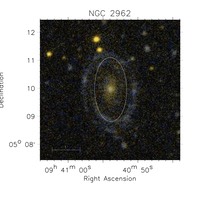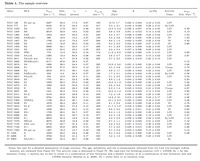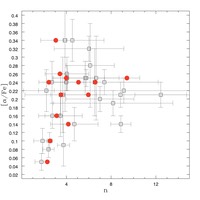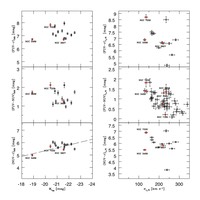False color image of NGC 2962 (FUV blue, NUV yellow). Notice the large blue ring/arm like structure. The ellipse represents the optical D25 isophote.

The advent of the Galaxy Ultraviolet Explorer (GALEX) has contributed to strengthen the idea that recent star formation is often present in ETGs. Through GALEX ultraviolet imaging Schawinski et al. (2007) found that 30% of massive ETGs show ongoing star formation and that this fraction is higher in LDEs. Rogers et al. (2007) concluded that ETGs in low density environments are less likely to present weak episodes of recent star formation than their high-density counterparts.
GALEX studies of ETGs with shell structures are of particular relevance, since these features, believed to be bona fide signatures of recent accretion/merging events, characterize a significant fraction (~16.5%) of field ETGs (see e.g. Malin & Carter 1983). Combined analyses of Lick line-strength indices (e.g. Mg2, Hbeta, H_gammaA, H_deltaA) and UV colours, revealed the presence of recent star formation in shell galaxies (see Rampazzo et al. 2007; Marino et al. 2009). Similar results have been recently obtained by (Jeong et al. 2009) for the SAURON galaxy sub-sample. They determine, for the first time, the ``UV Fundamental Plane'' and suggested that the dominant fraction of the tilt and the scatter of this plane is due to the presence of young stars in preferentially low mass ETGs.
We present GALEX FUV and NUV surface photometry of 40 ETGs drawn from the original sample of 65 nearby ETGs (Rampazzo et al. 2005; Annibali et al. 2006). The UV wavelengths are particularly sensitive to young populations, and thus ideal to characterize any recent star formation.
In general, the (FUV-NUV) radial color profiles become redder with galacto-centric distance. This behaviour is shown by both rejuvenated (<4 Gyr) and old ETGs. ETGs with central velocity dispersions higher than ~230 km/s tend to have central, re/8, (FUV-NUV) color bluer than those with lower velocity dispersion. Remarkable exceptions to what appears as a `normal' (FUV-NUV) radial color profile are detected in NGC 1533, NGC 2962, NGC 2974, NGC 3489, and of IC 5063 showing rings and/or arm-like structures, bluer than the body of the galaxy, suggesting the presence of recent star formation in general and likely on-going star formation in the arm-like structures of NGC 2962.
Although seven of our ETGs show shells systems in their optical image, only NGC~7135 displays shells in the UV bands. We characterize the UV and optical surface brightness profiles, along the major axis, using a Sersic law. The Sersic law exponent, n, varies from 1 to 16 in the UV bands. S0s tend to have lower values of n (<5). The Sersic law exponent n=4 seems to be a watershed: ETGs with n>4 tend to have [a/Fe] greater than 0.2, implying a short star-formation time scale.
more details in
Marino A., Rampazzo R., Bianchi L., Annibali F., Bressan A., Buson L.M., Clemens M.S., Panuzzo P., Zeilinger W.W.
Nearby early-type galaxies with ionized gas. The UV emission from GALEX observations
2010, MNRAS, in press


